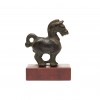
Horse

Photography by Synthescape, Digital image © Asia Society
Horse
1st-2nd century
China
Bronze
H. 2 3/8 x L. 2 1/8 x W. 5/8 in. (6 x 5.4 x 1.6 cm)
Asia Society, New York: Mr. and Mrs. John D. Rockefeller 3rd Collection, 1979.106
Licensing inquiries
The advent of horse-riding nomads on China's northern frontiers around the 6th century B.C.E. heralded a revolution in warfare. Although infantry continued to be the mainstay of armies within China, the development of cavalry was essential to combat the speed and mobility of hostile nomad incursions. Expeditions sent westwards during the reign of Emperor Wudi (reigned 140 - 86 B.C.E.) of the Han dynasty encountered in Ferghana (part of present-day Uzbekistan, Tajikistan, and Kyrgyzstan) a new breed of horse, superior to the native Chinese horse. The strength and speed of Ferghanan horses, imported in large quantities, amazed the Chinese, and became a favorite theme of painters and sculptors. Although small in size, this bronze figure of a horse relates in proportion to the much larger ceramic, wood and bronze tomb figures found in Eastern Han period tombs.

